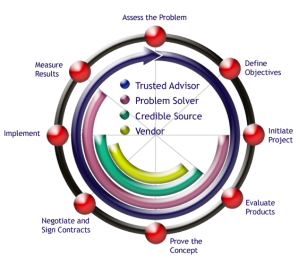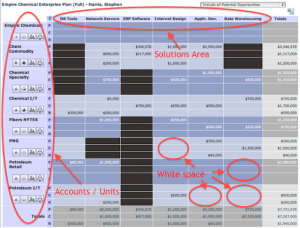Customer are not just for life – but for the network
Customer are not just for life – but for the network:from The Sales 2.0 Network
It is well understood that the cost of generating business from a new customer is much greater than acquiring business from a new customer. The least costly customer is the one who was referred by a satisfied customer. There are two dimensions to customer referral; 1) selling more to existing customers – perhaps in different business units in the same customer, and 2) delighting existing customers so that they become evangelists for you. The only difference between these two markets is the definition of the market. In the former case, the market is the broader market opportunity within the existing customer account, whereas the latter relates to a less structured, but in many cases equally connected market of ‘people like me’, or in other words, similar customers in a similar industry with similar problems.
My hypothesis, as mentioned elsewhere, is that businesses are less in control of the buyer/seller interaction – particularly in the Contact and Control phases of the interaction, between buyer and seller. Customer Lifetime Value must be coupled with Customer Network Value, the value that accrues to a seller because of the amplifying effect of the recommendation chain. Remember, customers are almost twice are likely to take a recommendation about a product or solution from ‘someone like them’ than from a company representative.
Network Effect
It is easy to get tired of the hyperbole that seems a requisite ingredient of Internet and Social Media conversations. For any industry you choose, somewhere in a garage in Silicon Valley, there is a group of college friends with an Internet connection and a few Macbooks, and a vision to ‘change forever’ how that industry works. But we know that we are entering the maturing stage of the Internet economy, characterized by a growing prevalence of ‘cloud-based’ services, online communities discussing and evaluating our products, and subscription-centric business models. Unless you take notice and effective action, you are likely to be left behind.Recent high-profile market entrants like Groupon, Zynga, Buddy Media, Pinterest, and Instagram have accrued value at a rate we’ve never seen before. That’s before we mention the ‘older’ stalwarts like Facebook or Twitter. Never in business history have so many companies generated so much value (at least for their shareholders) so quickly.
Each of these companies has a different mission or vision, and some would argue varying degrees of verisimilitude. In each case; one fact shines through. They all illustrate the amplifying impact of the power of the network, a concept first most uniquely evidenced by Hotmail – the free email service now owned by Microsoft.
In 1999, Fast Company published a story about Hotmail, and the lessons therein are as relevant now as they were then.
There is often an argument about the applicability of such examples to the B2B community, but, as mentioned earlier, while not all consumers are B2B buyers, all B2B buyers are consumers. As if by osmosis, people are conditioned to new ways of thinking by the interactions they have as consumers, and begin to expect similar capability or convenience in their business connections and interplays. And it happens without any one noticing; incremental changes in behavior and expectation, satisfaction and dissatisfaction.
I will say again: The fact remains that all business people – including both sellers and buyers – are consumers, and the lessons they learn in ‘consumer-land’ shape their thinking and expectations in “business-land’.
The problem I foresee is that some companies might fail to see the value of the network effect as an accelerant in both developing business in existing customers as well as in creating awareness, interest and preference in new accounts.
Helping Customers Buy
Traditional business theory would teach a method to understand the Customer Lifetime Value (CLV) – a mechanism to consider how much a business could extract from a customer over the lifetime of that customers interaction with the business. The thinking goes that because the cost of customer acquisition is high, you’re much better of getting more business from the same customer that acquiring new customers, and of course this is true. But it doesn’t end there, but it is important to understand how you can be part of the recommendation chain for your existing customers.I want to be clear that I do not recommend that you should cast aside older approaches to account development just because they are old, but rather learn from the past and enhance or modify to take advantage of the velocity and reach of the Social Universe. There is a risk that proven methodologies that have earned their rightful place as axiomatic principles in account development will be followed religiously without amendment, and without reference to the evolution we’ve witness in the Social Universe. Even more damaging is the risk that these proven axioms will be seen as too rigid in this new world – and therefore deemed irrelevant rather than modified, throwing the proverbial baby out with the bathwater. This is one time where evolution, rather than revolution, delivers most value.

In fact the old axiom that promotes the need to become a Trusted Advisor to your customer has never been more relevant. As you can see from the diagram here, Trusted Advisors are present in the buying cycle throughout the buying cycle, and in fact participate long before the buying cycle begins. They are an intrinsic link in the recommendation chain. The difference now is that one could argue that the gap between Trusted Advisor and Vendor, previously occupied by the Credible Source and the Problem Solver, has instead become a narrowing chasm in which failure lives.
In our business, customers use Dealmaker Smart Account Manager to gain a picture of their current status in an account, and identify ‘white space’ areas to explore for potential business. The goal is to identify areas in the customer’s organization where your solutions might solve known business issues for each division or business unit in the customer’s organization, or where you can identify previously unknown opportunities for improvement.
It focuses however on aligning sales opportunities with the customer’s goals using a strategy map to provide insight to the customer’s business goals. If you want the customer to be satisfied with the product/service you deliver, then you need to ensure that you understand the need the customer has.
You’d be forgiven for thinking that being a customer is easier than being a sales person. All the customer’s got to do is pick a supplier, right? But when the customer makes that buying decision, the risk shifts from the supplier to the customer – at least in the eye of the customer – and the impact on the customer of a poor buying decision is usually greater that the impact on the salesperson of a lost sale. That’s important enough to say again:
Many psychometric studies show that each of us has different approaches to social interaction, leadership, teamwork, and relative strengths or weaknesses when it comes to strategic or tactical bias, detail or big picture orientation, and introspection or engagement. Consider then that over the course of your business life you’re likely to encounter the full spectrum of customers or buyers who will exhibit varying proclivities for action, engagement, or precision.
Each customer will be different. Some will want to lead the buy-sell interaction; others are prepared to follow the direction of a trusted supplier. More are at their most comfortable when working in collaboration with their supplier, and it’s this latter category that is most common, and certainly most productive for both buyer and seller alike.
Whether the customers you’re dealing with are current customers or new prospects, you can be sure that each is active in the Social Universe, learning others in their industry and listening to ‘someone like me’, and looking for people that they can trust – who are part of the recommendation chain.
So, what’s the best model for customer interaction? Unfortunately there is no one answer that works in all cases, but there is a proven method that we would recommend that you follow. A collaborative approach to fully describing the problem being addressed is always instructive, even when customers exhibit tendencies of leader or follower.
The challenge often faced by a customer when looking to leverage the expertise of an external supplier can be summarized as:
- No easy or established way for the customer to map out the internal customer issues
- No mechanism to explain the business challenges to a supplier
- Uncertainly about whether the supplier understands the specific problem
- Need to gain alignment between customer and supplier to avoid any current or future misunderstanding
In May 2012, Quora, the question and answer site, raised $50m (at a valuation of $400m). According to Quora’s own website:
Quora connects you to everything you want to know about. Quora aims to be the easiest place to write new content and share content from the web. We organize people and their interests so you can find, collect and share the information most valuable to you
Quora is just one example of a crowd-sourced knowledge community, and it is noteworthy because of the depth of expertise exhibited by its members. But there are other places where your customer can go to find solutions to the problems they are experiencing; LinkedIn Groups, when effectively moderated, are a valuable source of experience waiting to be published and frequently are quite deep in very specific industry areas. If your customer is asking questions in these communities, and you are not there answering the questions, you can be sure that your competitors are.
It is harder than ever to attract new customers early in their buying process. You need to leverage your current customers by first delighting them, and then making it as easy as possible for them to recommend you to others by building your own on-line community, publishing customer videos on Youtube, and turning your most successful customers into your most powerful advocates.
In the next post, I will relate how Mark Benioff, CEO of salesforce.com, is a master of leveraging the network value of his customers.


No comments:
Post a Comment